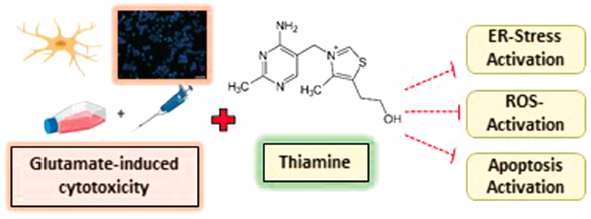Chemical & Pharmaceutical Bulletin ( IF 1.5 ) Pub Date : 2021-09-01 , DOI: 10.1248/cpb.c21-00169 Merve Ergül 1 , Ahmet Şevki Taşkıran 2
Thiamine (vitamin B1), which is synthesized only in bacteria, fungi and plants and which humans should take with diet, participates in basic biochemical and physiological processes in a versatile way and its deficiency is associated with neurological problems accompanied by cognitive dysfunctions. The rat glioblastoma (C6) model was used, which was exposed to a limited environment and toxicity with glutamate. The cells were stressed by exposure to glutamate in the presence and absence of thiamine. The difference in cell proliferation was evaluated in the XTT assay. Oxidative stress (OS) markers malondialdehyde (MDA), superoxide dismutase (SOD), and catalase (CAT) levels, as well as endoplasmic reticulum (ER) stress markers 78-kDa glucose-regulated protein (GRP78), activating transcription factor-4 (ATF-4), and C/EBP homologous protein (CHOP) levels, were measured with commercial kits. Apoptosis determined by flow cytometry was confirmed by 4′,6-diamidino-2-phenylindole (DAPI) staining. At all concentrations, thiamine protects the cells and increased the viability against glutamate-induced toxicity. Thiamine also significantly decreased the levels of MDA, while increasing SOD and CAT levels. Moreover, thiamine reduced ER stress proteins’ levels. Moreover, it lessened the apoptotic cell amount and enhanced the live-cell percentage in the flow cytometry and DAPI staining. As a result, thiamine may be beneficial nutritional support for individuals with a predisposition to neurodegenerative disorders due to its protective effect on glutamate cytotoxicity in glioblastoma cells by suppressing OS and ER stress.
 Fullsize Image
Fullsize Image
中文翻译:

硫胺素通过抑制氧化/内质网应激保护胶质母细胞瘤细胞免受谷氨酸毒性
硫胺素(维生素 B1)仅在细菌、真菌和植物中合成,人类应通过饮食摄取,以多种方式参与基本的生化和生理过程,其缺乏与伴随认知功能障碍的神经系统问题有关。使用大鼠胶质母细胞瘤 (C6) 模型,该模型暴露于有限的环境和谷氨酸的毒性。在硫胺素存在和不存在的情况下,通过暴露于谷氨酸对细胞施加压力。在 XTT 测定中评估细胞增殖的差异。氧化应激 (OS) 标记丙二醛 (MDA)、超氧化物歧化酶 (SOD) 和过氧化氢酶 (CAT) 水平,以及内质网 (ER) 应激标记 78-kDa 葡萄糖调节蛋白 (GRP78),激活转录因子-4 (ATF-4), 和 C/EBP 同源蛋白 (CHOP) 水平,用商业试剂盒测量。通过流式细胞术确定的细胞凋亡通过 4',6-二脒基-2-苯基吲哚 (DAPI) 染色确认。在所有浓度下,硫胺素都能保护细胞并增加对抗谷氨酸诱导毒性的活力。硫胺素还显着降低 MDA 水平,同时增加 SOD 和 CAT 水平。此外,硫胺素降低了内质网应激蛋白的水平。此外,它减少了凋亡细胞数量并提高了流式细胞术和 DAPI 染色中的活细胞百分比。因此,硫胺素可能是对易患神经退行性疾病的个体有益的营养支持,因为它通过抑制 OS 和 ER 应激对胶质母细胞瘤细胞中的谷氨酸细胞毒性具有保护作用。通过流式细胞术测定的细胞凋亡通过 4',6-二脒基-2-苯基吲哚 (DAPI) 染色确认。在所有浓度下,硫胺素都能保护细胞并增加对抗谷氨酸诱导毒性的活力。硫胺素还显着降低 MDA 水平,同时增加 SOD 和 CAT 水平。此外,硫胺素降低了内质网应激蛋白的水平。此外,它减少了凋亡细胞数量并提高了流式细胞术和 DAPI 染色中的活细胞百分比。因此,硫胺素可能是对易患神经退行性疾病的个体有益的营养支持,因为它通过抑制 OS 和 ER 应激对胶质母细胞瘤细胞中的谷氨酸细胞毒性具有保护作用。通过流式细胞术确定的细胞凋亡通过 4',6-二脒基-2-苯基吲哚 (DAPI) 染色确认。在所有浓度下,硫胺素都能保护细胞并增加对抗谷氨酸诱导毒性的活力。硫胺素还显着降低 MDA 水平,同时增加 SOD 和 CAT 水平。此外,硫胺素降低了内质网应激蛋白的水平。此外,它减少了凋亡细胞数量并提高了流式细胞术和 DAPI 染色中的活细胞百分比。因此,硫胺素可能是对易患神经退行性疾病的个体有益的营养支持,因为它通过抑制 OS 和 ER 应激对胶质母细胞瘤细胞中的谷氨酸细胞毒性具有保护作用。硫胺素保护细胞并增加对抗谷氨酸诱导毒性的活力。硫胺素还显着降低 MDA 水平,同时增加 SOD 和 CAT 水平。此外,硫胺素降低了内质网应激蛋白的水平。此外,它减少了凋亡细胞数量并提高了流式细胞术和 DAPI 染色中的活细胞百分比。因此,硫胺素可能是对易患神经退行性疾病的个体有益的营养支持,因为它通过抑制 OS 和 ER 应激对胶质母细胞瘤细胞中的谷氨酸细胞毒性具有保护作用。硫胺素保护细胞并增加对抗谷氨酸诱导毒性的活力。硫胺素还显着降低 MDA 水平,同时增加 SOD 和 CAT 水平。此外,硫胺素降低了内质网应激蛋白的水平。此外,它减少了凋亡细胞数量并提高了流式细胞术和 DAPI 染色中的活细胞百分比。因此,硫胺素可能是对易患神经退行性疾病的个体有益的营养支持,因为它通过抑制 OS 和 ER 应激对胶质母细胞瘤细胞中的谷氨酸细胞毒性具有保护作用。它减少了凋亡细胞数量并提高了流式细胞术和 DAPI 染色中的活细胞百分比。因此,硫胺素可能是对易患神经退行性疾病的个体有益的营养支持,因为它通过抑制 OS 和 ER 应激对胶质母细胞瘤细胞中的谷氨酸细胞毒性具有保护作用。它减少了凋亡细胞数量并提高了流式细胞术和 DAPI 染色中的活细胞百分比。因此,硫胺素可能是对易患神经退行性疾病的个体有益的营养支持,因为它通过抑制 OS 和 ER 应激对胶质母细胞瘤细胞中的谷氨酸细胞毒性具有保护作用。
 全尺寸图像
全尺寸图像









































 京公网安备 11010802027423号
京公网安备 11010802027423号